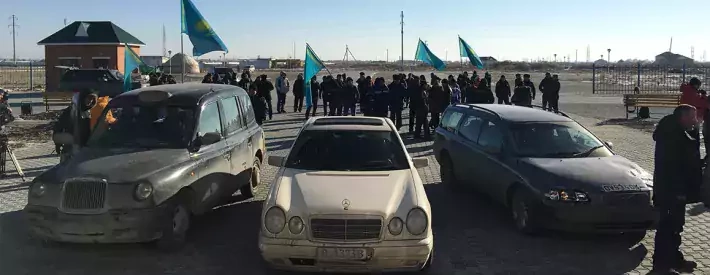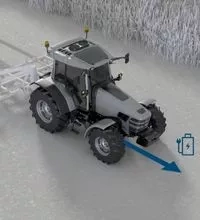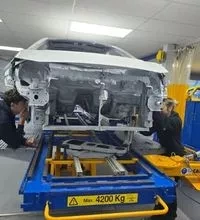The day I took a backcab to Kazakhstan

In this article: Former Top Gear presenter and motoring journalist Rory Reid fulfills a dream and takes a taxi to the Baikonur Cosmodrome in southern Kazakhstan
It’s happening. Well, almost. Ever since I was a teenager, I’ve gazed up at the sky in awe, wondering what it might be like to explore the stars. And then there I was, standing in front of a rocket about to take off from the very site where Yuri Gagarin had been launched into the black ether.
I’m not on that rocket, of course – I’m absolutely not qualified to pilot such a craft. But I’m doing the next best thing, because my job has taken me on an epic road trip culminating inside the secretive grounds of Baikonur Cosmodrome, a spaceport in southern Kazakhstan.
I’m standing a mile back from the launch pad, with half a dozen cameras trained on me, but I barely notice them. As the boosters fire, all I notice is the sky lighting up, the heat radiating across the plains, and the massive shockwave hitting my chest. The blast is strong enough to move me physically, but also emotionally.
Baikonur is a historic site, having been the starting point for many notable space missions. It was used to test the first operational intercontinental ballistic missile, and it later launched Sputnik 1 – the first satellite – and Vostok 1, the first manned space flight with Yuri Gagarin.
My trip to the so-called ‘Space City’ began in Turkistan, where I collected a 19-year old LTI TX1, an iconic black cab. I was joined by my two BBC Top Gear colleagues, Chris Harris (in a Volvo V70) and Matt LeBlanc (in a Mercedes E-Class). Between them, the cars had approximately half a million miles on the clock – the rough distance to the moon and back. Our task? To travel the 350 miles from Turkistan to Baikonur while winning as many challenges as possible along the way.
It’s huge
My first impression of Kazakhstan was that it’s massive. And massively cold. I had a pair of water bottles for the journey, and both quickly froze solid. To make matters worse, the heater in my cab was broken. Thankfully, the vest, two T-shirts, thermals and jumper I was wearing under my coat just about helped me win the war against hypothermia.
The initial leg of the journey took us through downtown Turkistan. The population milled about as you’d expect from the inhabitants of any city or town. Children walked to and from school, hungry folk disappeared in and out of fast-food joints, and commuters zipped about the place in the most remarkable collection of automotive tat. The place is a monument to Lada, Daewoo and Opel.
Leaving the city, I was struck by the state of Kazakhstan’s roads. The main conduit across this enormous country is the M32 highway, which starts near the Russian border in the north and extends as far as the city of Kyzylorda in the south – a 1,250 mile journey that takes a mammoth 40 hours. It’s not always possible to drive on certain sections of the road, so taking detours across the desert is sometimes a necessity.
Driving games
That was fine by us, because adventure lies away from the main roads. One of our best discoveries was a quarry in Kentau. Getting there involved a simple enough turn-off, followed by a trek across roads with potholes big enough to swallow a Land Rover. Eventually, the taxi, the Volvo and the Mercedes made it to a spot that was perfect for an impromptu race.
We lined up three abreast, waited for the signal and launched our cars along the slippery, unpaved switchbacks of the quarry road. To me, it was vaguely reminiscent of an alpine pass, minus the tarmac. By the time we reached the bottom of the quarry, I was somehow in the lead, understeering wildly across the gravelly surface towards a lake. I eventually pulled it together and started snaking my way back to the top.
The TX1 was surprisingly nippy when gravity was on its side, but it was fair game for the more powerful Mercedes and Volvo on the way back up. The E-Class soon caught and passed me but then suddenly lost drive. I tried to prevent the Volvo passing me too by making some fairly ungentlemanly changes of direction, but it eventually shot around the taxi… only to crash violently into the back of the Mercedes. With the other cars damaged, I chugged over the line to victory.
Such shenanigans were par for the course over the hundreds of miles that followed. Google Earth is your friend in a place like this – a quick scan reveals new playgrounds almost everywhere.
Later, we crossed some marshland and eventually found an enormous salt flat. It wasn’t exactly Bonneville, but it was perfect for a no-hands drag race. After that, it was time to watch a game of buzkashi, which involves two teams of men on horseback trying to throw a goat’s carcass into a giant bowl. This was followed by a celebratory meal with the players, where the main course included a horse’s face.
3, 2, 1, lift-off
Back on the road, we started on the final push into Baikonur City, where one more challenge awaited: to put as many extra miles on the clock in as little time as possible. I cheated a little (well, no rules were specified) by jacking up my taxi and allowing the wheels to spin freely for hours, which was enough to claim victory.
My prize was the guaranteed survival of my car, which I then used to chauffeur my colleagues into the grounds of the space station and towards the launch site. A rocket launch is an event I’ve always longed to witness in person, and it’s something few people get to experience.
As the countdown ended and the rocket climbed, I thought back to the days when 13-year-old me would peer at the stars through a cheap telescope on a dark street corner near my South London home. I’d always dreamed of seeing first-hand what it might be like to watch humanity take giant steps towards the stars. And with the assistance of a very reliable London taxi, and a little help from some friends, now I know.




